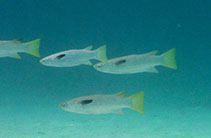Ellochelon vaigiensis (Quoy & Gaimard, 1825)
Squaretail mullet
個人による観察記録の追加 Fish Watcher
| Native range | All suitable habitat | Point map | Year 2050 |

|
| This map was computer-generated and has not yet been reviewed. |
| Ellochelon vaigiensis AquaMaps Data sources: GBIF OBIS |
Thailand country information
Common names:
Krabokthontai, กระบอกท่อนใต้
Occurrence: native
Salinity: brackish
Abundance: | Ref:
Importance: | Ref:
Aquaculture: | Ref:
Regulations: | Ref:
Uses: no uses
Comments: Known from Klong Wan (Prachuap Khiri Khan), Gulf of Thailand, Songkhla, Phuket, Andaman sea and Si Racha (Chon Buri) (Ref. 37773).
National Checklist:
Country Information: https://www.cia.gov/library/publications/resources/the-world-factbook/geos/th.html
National Fisheries Authority:
Occurrences: Occurrences Point map
Main Ref: Fish Team of the Trang Project, 2002
National Database:
Occurrence: native
Salinity: brackish
Abundance: | Ref:
Importance: | Ref:
Aquaculture: | Ref:
Regulations: | Ref:
Uses: no uses
Comments: Known from Klong Wan (Prachuap Khiri Khan), Gulf of Thailand, Songkhla, Phuket, Andaman sea and Si Racha (Chon Buri) (Ref. 37773).
National Checklist:
Country Information: https://www.cia.gov/library/publications/resources/the-world-factbook/geos/th.html
National Fisheries Authority:
Occurrences: Occurrences Point map
Main Ref: Fish Team of the Trang Project, 2002
National Database:
Common names from other countries
分類 / Names 共通名の | 類義語 | Catalog of Fishes(部類, 種) | ITIS | CoL | WoRMS | Cloffa
Issue
Genetic data indicate that Ellochelon vaigiensis is a complex of species (Ref. 114224). At least 3 species have been recognized (Refs. 114224, 123263, work in progress) and are being described, with probable parapatric distributions (Durand, pers. comm., Nov. 2020).
Environment: milieu / climate zone / depth range / distribution range 生態学
海; 新鮮な水; 汽水性の 関連する礁; 降流性の (Ref. 46888); 深さの範囲 0 - 5 m (Ref. 89972). Tropical; 32°N - 24°S, 30°E - 141°W
分布 国々 | 国連食糧農業機関の区域 | エコシステム | 事件 | Point map | 導入 | Faunafri
Indo-Pacific: Red Sea and from East Africa to the Tuamoto Islands, north to southern Japan, south to southern Great Barrier Reef and New Caledonia (Ref. 9812).
サイズ / 重さ / 年齢
Maturity: Lm ? range ? - ? cm
Max length : 63.0 cm TL オス/雌雄の選別がない; (Ref. 9710); common length : 35.0 cm TL オス/雌雄の選別がない; (Ref. 9812)
Max length : 63.0 cm TL オス/雌雄の選別がない; (Ref. 9710); common length : 35.0 cm TL オス/雌雄の選別がない; (Ref. 9812)
簡単な記述 検索表 | 形態学 | 形態計測学
背面の脊椎 (合計) : 5; 背鰭 (合計) : 8 - 10; 肛門の骨: 3; 臀鰭: 7 - 9. Diagnosis: This species is distinguished by the following characters: robust body; usually with 16 pectoral-fin rays; 25-29 longitudinal scales; 16 circumpeduncular scales; weakly ctenoid scales; adults with longer snout than eye diameter, shorter in juvenile; poorly developed adipose eyelid, forming narrow rim around eye; weak notch on anteroventral edge of preorbital; truncate caudal fin; colour olive-brown dorsally, flanks and belly silvery to whitish; about 6 brownish stripes on flank formed by longitudinal marks on scales; fins yellowish white with dusky margins except caudal fin yellow and pectoral black dorsally and yellow ventrally (completely black in young); no axillary scale visible in the pectoral fins (Ref. 9812, 90102).
Found in lagoons, reef flats, estuaries, and coastal creeks, in shallow coastal areas and protected sandy shores (Ref. 40488). Usually within tidal influence, but may enter fresh water, ascending 10 km into rivers (Ref. 40488). Forms large schools, frequently in mangrove areas (Ref. 2334). Juveniles may be found in rice fields and mangroves and may be used as bait fish (Ref. 9812). Oviparous, eggs are pelagic and non-adhesive (Ref. 205). Feeds on phytoplankton, small algae and detritus organisms (Ref. 89972). Caught in cast nets, stake
nets, beach seines, and gill nets; marketed fresh and salted; boiled (Thailand), canned or frozen (Australia). Roe also marketed salted and juveniles used as bait fish (Ref. 9812)..
Life cycle and mating behavior 成熟 | 繁殖 | 放精 | 卵 | 生産力 | 幼生
主な参考文献
Upload your references | 参考文献 | コーディネーター : Harrison, Ian | 協力者
Myers, R.F., 1991. Micronesian reef fishes. Second Ed. Coral Graphics, Barrigada, Guam. 298 p. (Ref. 1602)
Human uses
水産業: 商業; 水産養殖: 商業; 水族館・水槽: 商業; 餌: occasionally
FAO(Aquaculture systems: 代謝; ; publication : search) | FishSource | 私達の周りの海
より多くの情報
Population dynamics
成長のパラメーター
Max. ages / sizes
Length-weight rel.
Length-length rel.
体長組成
Mass conversion
補充
豊度
成長のパラメーター
Max. ages / sizes
Length-weight rel.
Length-length rel.
体長組成
Mass conversion
補充
豊度
Physiology
Body composition
Nutrients
酸素消費
水泳形態
泳ぐ速さ
Visual pigments
Fish sound
Diseases & Parasites
Toxicity (LC50s)
Body composition
Nutrients
酸素消費
水泳形態
泳ぐ速さ
Visual pigments
Fish sound
Diseases & Parasites
Toxicity (LC50s)
Genetics
遺伝子の
Heterozygosity
遺伝
遺伝子の
Heterozygosity
遺伝
用具
E-book | 野外観察図鑑 | 検索表 | Length-frequency wizard | 生活史の基盤ツール | 目的のマップ | Classification Tree
| Catch-MSY |
特記事項
XMLをダウンロードして下さい
インターネットの情報源
Aquatic Commons | BHL | Cloffa | Websites from users | Check FishWatcher | CISTI | Catalog of Fishes(部類, 種) | DiscoverLife | ECOTOX | Faunafri | Fishtrace | GenBank(ゲノム, ヌクレオチド) | GloBI | GOBASE | | Google Books | Google Scholar | Google | IGFA World Record | MitoFish | Otolith Atlas of Taiwan Fishes | PubMed | Reef Life Survey | Scirus | SeaLifeBase | 生命の木 | Wikipedia(行く, 検索する) | World Records Freshwater Fishing | 動物に関する記録
Estimates based on models
Preferred temperature (Ref. 115969): 25.3 - 29.3, mean 28.5 (based on 3039 cells).
Phylogenetic diversity index (Ref. 82804): PD50 = 1.0000 [Uniqueness, from 0.5 = low to 2.0 = high].
Bayesian length-weight: a=0.01202 (0.00759 - 0.01905), b=3.02 (2.89 - 3.15), in cm Total Length, based on LWR estimates for this species & (Sub)family-body (Ref. 93245).
栄養段階 (Ref. 69278): 2.2 ±0.1 se; based on diet studies.
回復力 (Ref. 120179): 手段, 1.4年~4.4年の倍増期間の最小個体群 (Preliminary K or Fecundity.).
Fishing Vulnerability (Ref. 59153): Moderate to high vulnerability (45 of 100).




